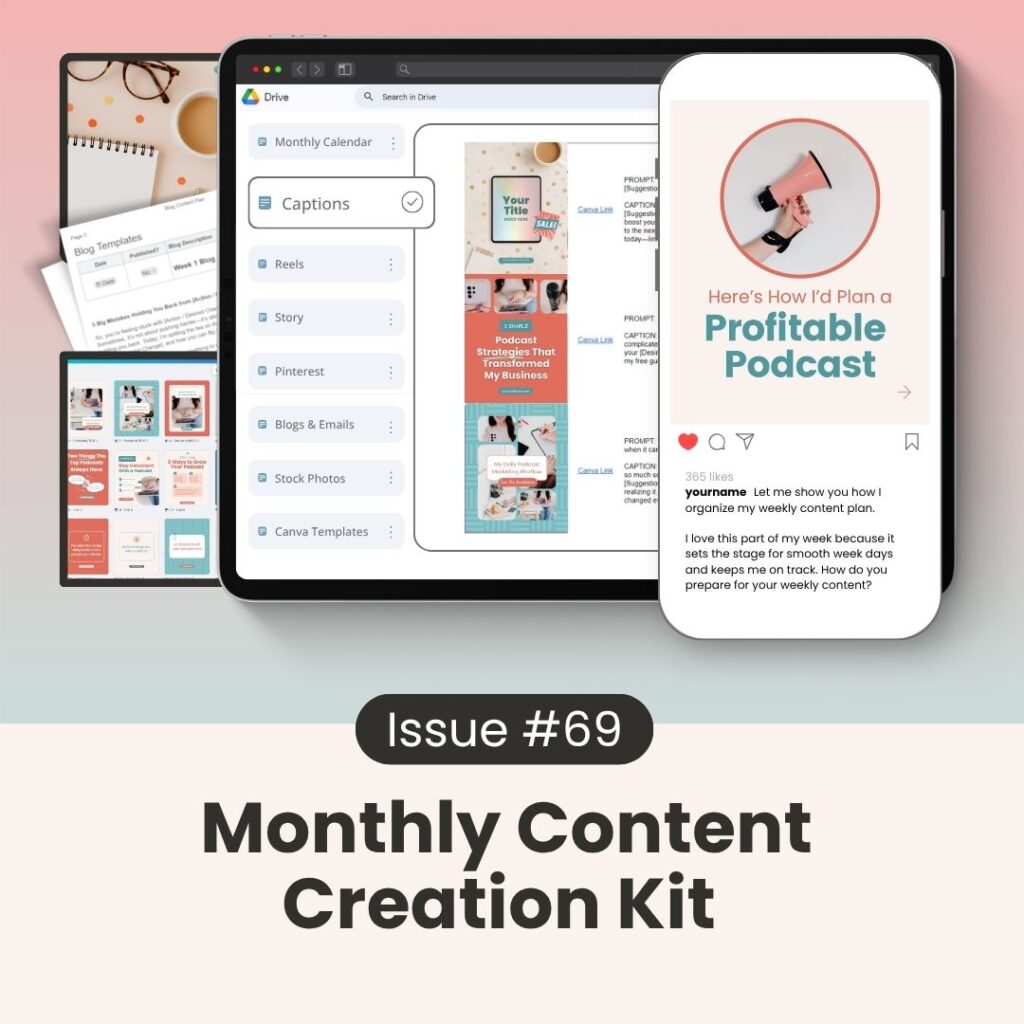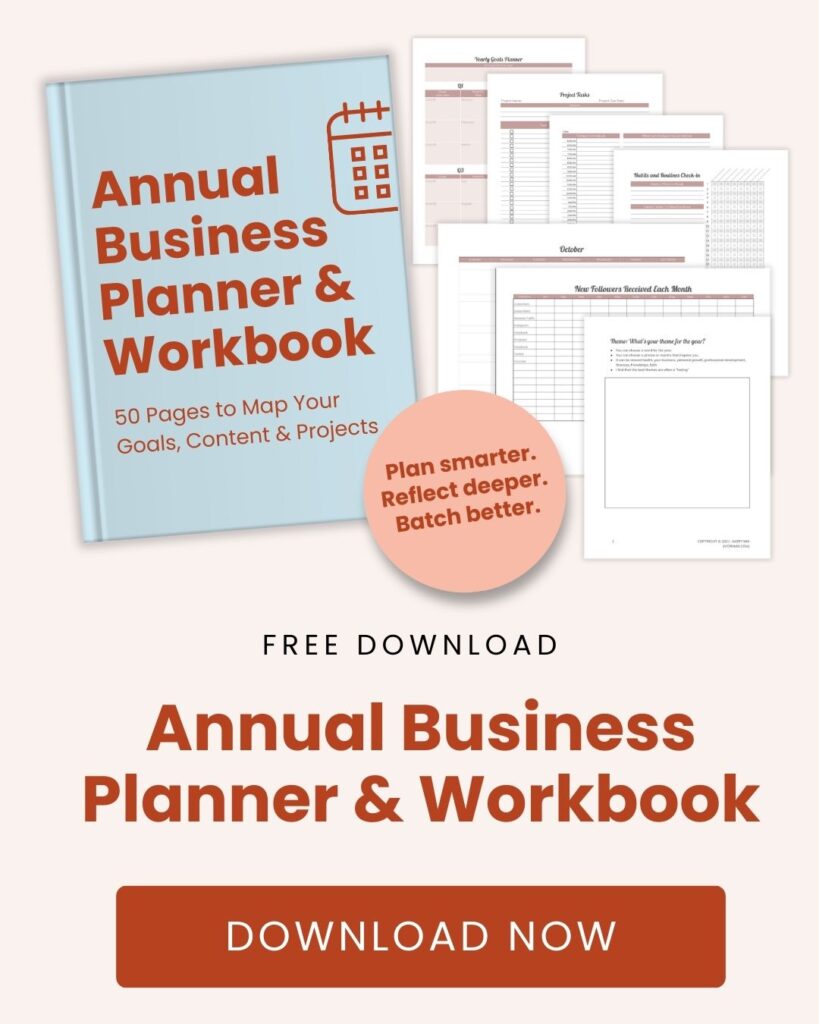get 500+ free images, templates & marketing strategies! You're one click away, Don't Miss It.
10 Steps to Set Goals and Make a Business Plan For the New Year
This post may contain affiliate links. Please read the disclaimer
A lot of people think they struggle with planning for their business because they cannot stay motivated or they are not disciplined enough, but usually that is not the real issue at all. Most plans fall apart because they were built for a version of us who has way more time, energy, focus, and clarity than we actually have on a regular week. So it is not that you cannot follow through, it is usually that the plan was not created with real life in mind.
I have created some very pretty plans that looked organized and motivating, but once life got even a little busy or my energy shifted, they stopped working. When I finally started planning based on the version of me who actually shows up most days, planning started to feel easier, calmer, and more supportive instead of stressful or heavy.
Before you build your plan, you can download the free Annual Business Planner and Workbook inside the Free Guides Library. It will help you map everything out clearly instead of trying to remember it all in your head.
Download my free Annual Planner and Yearly Journal (50 page pdf)
Now let us build something that you can live with, not something that looks impressive for a week and then collects dust.
Step One: Decide what you want to be able to say at the end of the year
Think about what you want to look back on and feel proud of. Choose something that would genuinely matter to you, not something that only sounds impressive or looks like a perfect goal on paper.
Example ideas
• finishing a digital product that has been in your head for too long
• staying visible and consistent in your content without burning out
• having simple business systems that make everything easier
• increasing income in a way that feels steady, not exhausting
Action step: Write one sentence that feels honest and exciting, not something you only choose because it sounds like what you are supposed to want.
Step Two: Write down why it matters right now
Your reason does not need to sound inspirational or deep. You just need to understand why this goal feels important for the season you are in now. When you are clear about this, it becomes easier to stay with it even when your energy or mood shifts.
Questions that help
• what feels like it would get easier if I reach this
• what stress or worry could it reduce
• what would finally feel like real progress
Action step: Put your answer somewhere you will see during low energy days, not only on the days when you feel motivated.
Step Three: Be honest about how much time and energy you really have
Most people plan based on their best days and then feel discouraged when the plan is too heavy to keep up with. Instead, try to build your plan around what an average week usually feels like, because that is the version of you who will actually be living it.
Think about
• how your weeks normally go
• your ongoing responsibilities
• what feels easy for you to do and what drains you fast
• how often you have time for focused work
Action step: Decide how many work blocks or hours you can stay consistent with even when the week feels messy or slower.
Step Four: Break your year into four smaller chapters
Looking at an entire year can feel overwhelming, so divide it into four parts with different focuses. This makes it easier to know what you should be working on right now instead of trying to do everything at once.
Example chapter flow
• Q1 create or build
• Q2 edit or improve
• Q3 grow or optimize
• Q4 promote expand or finalize
Action step: Write a simple focus for each quarter that feels doable.
Step Five: Pick fewer projects so you can actually finish them
Starting many things can feel productive in the moment, but finishing things is what builds confidence and results. Most people do not need more ideas. They need more completion and more focus.
Try thinking like this
• choose one main outcome for each quarter
• limit yourself to no more than three big projects for the entire year
• let everything else wait without guilt
Action step: Circle the most important projects and let the rest sit on a later list.
Step Six: Give each month a focus so you do not multitask your entire year
Daily routines can be great if they work for you, but for many people they become overwhelming. Monthly themes provide structure without pressure and give your brain one thing to focus on.
Theme ideas
• simplify
• create
• nurture
• learn
• promote
• rest
Action step: Choose one focus for each month so you always know what matters most.
Step Seven: Choose habits that help you stay in motion
Big goals might feel exciting, but small steady habits are what move things forward. These habits become easier to return to even after a slower period.
Examples
• publish weekly content
• send one email every week
• review numbers once a month
• try one new growth action each month
Action step: Choose one weekly and one monthly habit that support your main goal.
If content is the thing that keeps slowing you down, you do not have to build everything from scratch.
Our Monthly Content Kits give you ready to use writing and ideas so you can create faster and stay visible.

Step Eight: Build simple systems that make things easier to repeat
A system does not have to be fancy or complicated. It just needs to help you think less and move faster in areas that are repeated.
Simple system ideas
• a content batching routine
• an idea storage list
• an onboarding template
• a weekly planning checklist
Action step: Choose one area that feels harder than it should and build the easiest possible system first.
Step Nine: Plan for slow or unpredictable weeks
Every year has seasons where you feel tired or distracted or pulled into other things. Planning for that ahead of time helps you continue even when your energy is lower.
Think about
• what bare minimum looks like
• what a pause could look like without quitting
• how to return without feeling behind
Action step: Write a simple low energy version of your plan so you can stay in motion without pressure.
Step Ten: Check in every ninety days and adjust if needed
Your plan is not something you have to follow perfectly. It is something you are allowed to adjust. The goal is clarity and progress, not perfection.
Questions to review
• what worked and why
• what felt heavy and why
• what needs to change
• what deserves celebration
Action step: Add your quarterly review dates to your calendar.
Final Reminder
You do not need to become a new person to succeed this year. You just need a plan that fits who you are and how your life actually works. When your plan fits you, it becomes something you can keep doing through good weeks and slower ones, and that is what creates long term results.
Why Join the Ivory Mix Membership
If you want help staying consistent with content and marketing for your business, being visible, organized, and confident with your business all year, the Ivory Mix Membership gives you tools that remove guesswork so you can focus on creating, finishing, and growing instead of constantly starting over. To start saving time and creating more engaging content – sign up here.

Included Free:
550+ Templates, Photos, & Strategies
Get New Free Downloads Monthly
Unlimited Downloads
Special offers & Trends Newsletter
Save and sort your favorites
Access 500+ Free Templates, Photos, & Strategies With A Free Account
Free User Creation for Popup
By creating an account, I agree to Ivory Mix's Website terms, Privacy Policy and Licensing Terms
Already have an account? Log in












